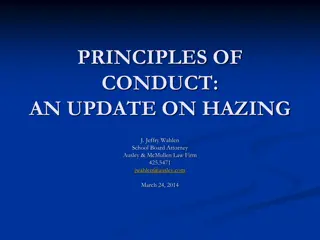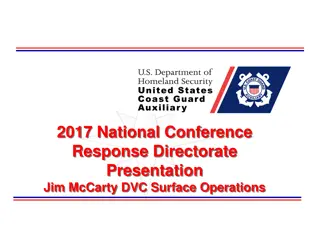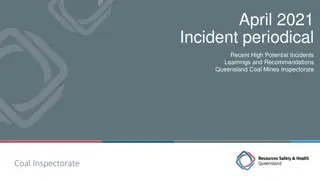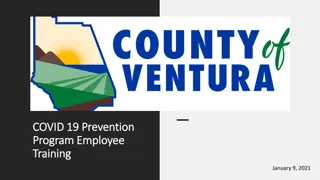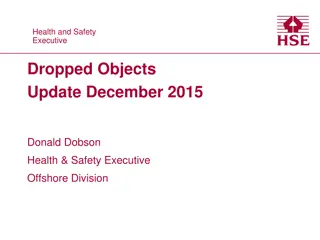Process Safety Incidents and Prevention Best Practices
Process safety incidents involving hazardous materials like caustic solutions, ammonia leaks, and TFE have caused injuries and fatalities. Key incidents include burns from caustic exposure, fatalities due to ammonia leaks, and an explosion from improper TFE handling. Learning from these incidents highlights the importance of strict safety protocols, proper equipment maintenance, and effective communication in preventing such tragedies.
Download Presentation

Please find below an Image/Link to download the presentation.
The content on the website is provided AS IS for your information and personal use only. It may not be sold, licensed, or shared on other websites without obtaining consent from the author.If you encounter any issues during the download, it is possible that the publisher has removed the file from their server.
You are allowed to download the files provided on this website for personal or commercial use, subject to the condition that they are used lawfully. All files are the property of their respective owners.
The content on the website is provided AS IS for your information and personal use only. It may not be sold, licensed, or shared on other websites without obtaining consent from the author.
E N D
Presentation Transcript
Process Safety Best Practice Line Break Program
Recent Incident #1 Hi Temp Caustic During "routine maintenance", an operator was cleaning an inline filter connected to pipework below a thickener tank. He opened the drain valve to verify isolation before undoing four bolts to open the inline filter door. On opening the inline filter door, the operator found the screen/filter full of material. As he pulled the screen/filter out of its housing, a blockage upstream of the screen/filter box dislodged. The operator was engulfed in 203 F (95 C) caustic solution, receiving thermal and caustic burns to his body and face. An emergency responder found the main isolation valve open!
Incident #2 Anhydrous Ammonia (NH3) One (1) refrigeration technician died and one was in a coma for 5 months and had to have a double-lung transplant due to a NH3 leak at a food plant. USDA inspected the poultry plant and ordered the facility to replace a part in a NH3 heat exchanger, which chills poultry before packaging. Company decided to use its own employees to install the part. Instructions for replacing the inner sleeve included a WARNING that all of the refrigerant NH3- must be removed first. The deceased technician was in charge of maintaining the heat exchanger and was given the manufacturer s instructions. He summoned another technician, who was working elsewhere in the plant for help. The deceased refrigeration technician was unscrewing a valve when the other refrigeration technician entered the room. "As he saw XXXXXX unscrewing the valve, XXXXXXX - who was aware of the fact that the heat exchanger contained NH3 shouted at XXXXXXX: Stop, XXXXX, stop . "However, his warning was too late as the pressure behind the partially opened sleeve forced ammonia out of the exchnager in an explosive manner, which caused the room to be filled with ammonia almost instantaneously."
Incident #3 Tetrafluoroethylene (TFE) Four (4) employees were engaged in finding a polymer plug that would occasionally occur due to polymerization in the line. They had performed a line break and had reassembled the line, and then opened a tetrafluoroethylene (TFE) valve at a silica gel tower. This allowed full pressure on the line. Due to a poorly connected flange, air had been introduced into the line after reassembly and when the TFE came into contact with the air a fire resulted leading to an explosion of the tower. Two of the four employees were unable to escape the fire, and two others escaped the fire scene. Only one (1) of the two employees that escaped survived and was hospitalized with burns. Returning to service AFTER the opening is CRITICAL!
Basic LOTO and Permitting FAILURES! The PTW system is ONLY as good as WE MAKE IT! Incident #4 Black Liquor Workers were removing a pump for the black liquor storage tank. Operators are tasked with valve LOTO in this line for this task. LOTO of the main circuit for the pump was done by mechanics #1 and #2 Operator filled out the permit with the intent of coming back in what he thought would be a couple minutes to close the valves for which he was responsible. He did not expect that the maintenance workers would start as soon as they had. Operator was responsible for closing the valve on the suction side of the pump, which he did NOT do before issuing the permit! Mechanics checked the bleed off valve for the pump and nothing came out. One noticed that the bleed off valve was caked with dried weak liquor and attempted boring it with a wire brush and no solvent came out. Mechanic stated that the valve on the suction side was not seen, when he checked the other valves. They began removing the bolts from the pump. The last four bolts were loosened, and they began prying the pump away, when the black liquor was released. Both employees ran out the door to the showers as the release occurred, but sustained chemical burns and were hospitalized.
PSM & RMP Requirements 1910.119(f)(4) and 68.69 The employer [owner or operator] shall DEVELOP AND IMPLEMENT SAFE WORK PRACTICES to provide for the control of hazards during operations such as lockout/tagout; confined space entry; OPENING PROCESS EQUIPMENT OR PIPING; and control over entrance into a facility by maintenance, contractor, laboratory, or other support personnel. These safe work practices shall APPLY TO EMPLOYEES AND CONTRACTOR EMPLOYEES. Line Break/Process Opening can be one of the HIGHEST RISK activities within a covered process and yet we have NO standards/codes/RAGAGEPs
NON-ROUTINE Work Authorizations 1910.119 Appendix C (Non-Mandatory) NON-ROUTINE Work Authorizations states... NONROUTINE WORK which is conducted in process areas needs to be CONTROLLED by the employer in a consistent manner. Hazards MUSTBE COMMUNICATED to those doing the work, but also to those operating personnel whose work could affect the safety of the process. Work permit MUST HAVE A PROCEDURE THAT DESCRIBES THE STEPS [that personnel] need to follow to obtain the necessary clearance to get the job started. The work authorization procedures need to reference and coordinate, as applicable, LOCKOUT/TAGOUT PROCEDURES, LINE BREAKING PROCEDURES, CONFINED SPACE ENTRY PROCEDURES and HOT WORK authorizations. Procedure also needs to PROVIDE CLEAR STEPS TO FOLLOW ONCE THE JOB IS COMPLETED in order to provide closure for those that need to know the job is now completed and equipment can be returned to normal.
Routine vs. Non-Routine Routine Openings Sampling Unloading/Loading Hose Connections Cleaning Strainers Changing Filters Prescribed Maintenance Activities Non-Routine Openings Valve maintenance/replacement Instrument replacement Pipe/Spool Piece Replacement Opening drains/vents associated with energy isolations Un-prescribed Maintenance Activities
Routine Openings Routine needs to be DEFINED/QUNATIFIED by the facility Daily, Weekly, Monthly, Quarterly Routine Openings SHOULD BE covered by a documented Operating Procedure that is ANNUALY CERTIFIED and trained on at least every three (3) years The rationale is that these routine openings can have a lesser risk profile through PROPER DESIGN, PLANNING, and HAZARD MITIGATION JSA/JHA and a Certified PPE Hazard Assessment (1910.132(c)) SHOULD BE performed on EACH ROUTINE OPENING task and the Hierarchy of Controls applied
NON-ROUTINE OPENINGS Openings that are so rare that the facility has NO DOCUMENTED procedure(s), NO pre-planning has taken place, NO formal risk analysis, etc. Non-Routine openings SHOULD BE managed with a Permit-To-Work (PTW) system The PTW should include a JSA/JHA, energy isolation plan, PPE Hazard Assessment, and emergency actions on EACH Non-ROUTINE opening and the Hierarchy of Controls applied
Fundamentals of a Line Break/Process Opening Permit-To-Work (PTW) Process
Permit To Work (PTW)! OSHA/EPA require a SAFE WORK PRACTICE for opening process equipment or piping ; however, there is NO requirement the program include a permit It is our opinion Having a line break program WITHOUT A PERMIT is just a waste of good paper! We use permits to control other hazardous activities (e.g. LOTO, PRCS, HW, Working @ Heights, etc.) within our facilities Opening a process that normally contains a HHC/EHS may be one of the more hazardous task personnel can do and not having this extra layer of administrative control is a major miss.
Scope of the program? The scope of the program means a lot and many make the mistake of including ONLY their covered processes so that they can comply" with PSM/RMP. Do we really think that any of the HHC s/EHS s are less hazardous to workers opening a process merely because the process is under the PSM/RMP threshold? When it comes to opening process equipment and/or piping, PSM/RMP thresholds MEAN VERY LITTLE to the worker(s) and process safety! Opening process equipment or piping w/ 10 pounds of Chlorine, not the PSM 1,500 pound threshold, is all that is needed to pose a significant risk to workers and the process and even the community.
Scope of the program? Although the PSM and RMP chemicals are a great place to start with making a list of inclusive chemicals, we SHOULD NOT STOP there! Easy method to assess HAZARDOUS MATERIALS that should be considered for inclusion in the program: NFPA 704 Health Rating > 3 NFPA 704 Flammability Rating > 3 NFPA 704 Reactivity Rating > 3 Solution with a pH > 9 or < 5 (unknown concentration) Solution with a temperature >130 F Solution with a BP<100 F Simple or Chemical Asphyxiant Combustible Dust Pressurized system that normally operates over 50 psi
Vapor Pressure means a lot Some facilities have a neat way of using VP as one of the means to include materials in their scope Some use the VP > 100 mm Hg as a means to identify materials that can pose an inhalation hazard and/or develop a hazardous vapor cloud (e.g. toxic, flammable or asphyxiant) Consider this: opening process equipment or piping that contains a hazardous material in liquid form can pose DUAL HAZARDS: liquid contact hazard and inhalation hazard if the VP > 100 mm Hg
OPENING/BREAK location goes so do RISKS Opening process equipment can be quite hazardous at GROUND level; but imagine opening the process 30 in the air Working 30 in an aerial lift, on scaffolding, or from a ladder when the line UNEXPECTEDLY releases its contents INCREASE RISKS Working at Heights permit ? Working at heights while OPENING the PROCESS can create an IDLH atmosphere with VERY LIMITED MEANS OF EGRESS!!!! EXPECTED the UNEXPETED PLAN FOR THE WORST HOPE FOR THE BEST
EGRESS is KEY! Opening process equipment in an area with POOR EGRESS, either because of additional piping or working @ heights should be considered EXTREMELY HAZARDOUS So HAZARDOUS, that poor egress should result in ADDITIONAL LAYERS OF PROTECTION such as increased ENERGY ISOLATION and/or INCREASED LEVELS of PPE to ensure the lack of egress is compensated for For example, workers in an aerial lift opening a process line with a high VP chemical would require DOUBLE BLOCK isolation (engineering control/isolation), Stand-by person at ground level who is trained in the emergency operation of the lift, and workers level of PPE may be increased to LEVEL A with a minimum of a 4500 psi pressure-demand SCBA Some openings may necessitate that a RESCUE TEAM be present during the INITAL break/opening! DON T FORGET that egress at ground level can even become limited! Personnel involved in the permitting and the actual work MUST verify, and continue to verify, that the workers have a CLEAR and UNOBSTRUCTED egress path should something go wrong
SAFETY LAYERS Stand-By personnel are common for LB Permits Concept mirrors 1910.134(g)(3) Procedures for IDLH atmospheres Energy Isolation (e.g. LOTO) is an ABSOLUTE! PPE should be based on the conditions BEFORE the line/equipment is prepared for opening! ALWAYS ASSUME the HHC/EHS is present at its highest temp, greatest pressure, etc. and SUIT UP for this degree of HAZARD for the 1stbreak Some openings may need LEVEL B and maybe even LEVEL A protection! ALWAYS break the bolts FURTHEST AWAY FIRST STAY OUT of the LINE OF FIRE Permit is ISSUED @ the point of OPENING! Permits covers ONLY ONE (1) OPENING additional permit(s) required for additional openings???
Safety Equipment Nearest safety shower/eyewash identified during the permitting process FLOW EW/SS to ensure it operates Nearest means to sound the alarm must be identified This could be a phone, pull station, or maybe even the safety shower/eye wash if it is alarmed back to an occupied location (i.e. control room) Communications between primary and back-up personnel, as well as a means to call for emergency assistance Having respirator available MAKES NO SENSE for Line Break WORK!!! It is either NEEDED or not!
Returning to Service PTW systems should address CLOSURE of the permit! LB Permit CLOSURE should address the following: VISUAL INSPECTION by a qualified examiner Process appears to be constructed correctly with labels, insulation, supports, bonding/ground systems, etc. PUT BACK IN PLACE PHYSICAL TESTING of equipment that was open Pressure Testing/Leak Testing (ANSI B31.3) Hydro or Pneumatic Pressure Testing Procedure? Bolt tightening technique, including torque values
Questions or Concerns? Copies of Line Break permits and written programs can be downloaded from the conference folder Jonathan Zimmerman, MS, CSP, CHMM EHS Manager Bryan Haywood, MS Founder & CEO SAFTENG.net LLC ?









